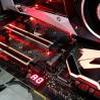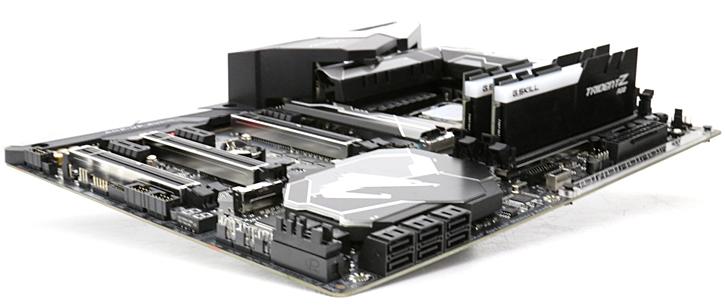Final Words & Conclusion
Conclusion
Gigabyte has got a lovely offering at hand with the Aorus Z370 Gaming 7. The product is feature rich and offers plenty of extras on a well-designed platform. That platform overall, even with the beta BIOS, was rock solid in both performance and stability. The tweaking performance as well was good and easy to set up. Gigabyte is advancing with the new Aorus line of products, and the Gaming 7 certainly is a good anwer to what the market desires, this is a good looking product. I do need to mention though that I miss WIFI or the new 5 Gbps LAN connection. I also feel I would have happily forfeited the two Gigabit jacks for just one 5 Gbps jack. Overall in its default non-overclocked setup, the platform also manages heat and power consumption at very acceptable levels.
Performance & tweaking
We tested multiple Z370 motherboards all with the latest BIOS, the Aorus Z370 Gaming 7 seems to be really fine tuned. Once tweaked we noticed that the six cores like extra voltage, we expect all-core tweaks in the 5 GHz marker to need 1.35~1.38 Volts on the processor. While that does increase power consumption significantly, it wasn't something that scared me away. Temps at such voltages reach the 80 to 90 Degrees C marker. We did however use an ES sample, perhaps the final retail product can do with a little less juice. Overall though, we did manage to reach 5.2 GHz on all six cores stable, and that is impressive. If you plan a tweak at that 5 GHz marker then remember my remarks on cooling, you will need LCS, that or a very good heatpipe cooler. Again, we have been using an ES sample so I cannot say anything conclusive on the final retail products (these might run a tiny bit cooler). The infrastructure that Z370 offers is easy to use, you increase the CPU voltage and multiplier and you are good to go. Another plus for the Intel platform is that over the years they have been able to refine their memory controllers, pop in anything XMP 2.0 and you have a 90% chance it'll work straight out of the box with very fast memories. Mind you, all our tests are performed at 3200 MHz DDR4, similar to Ryzen and Threadripper, to remain objective and for fair play on both sides.
Power consumption
Z370 with a six-core, twelve threaded proc equals a 95 Watt TDP processor. With the system at idle with a GeForce GTX 1080 installed / 16 GB memory / SSD and the Z370 motherboard I hovered at roughly 50 Watts in IDLE. That's just fine and normal really, but the load values are okay as well. When we stressed the processor 100% run we reach roughly 150 Watts with the 6-core 8700K part. When we game we hover at ~250 Watts with the GeForce GTX 1080, but obviously that factor is dependent on the type of graphics card you use of course and sure, most games certainly do not utilize the six CPU cores. Overall I have no worries here.
DDR4 Memory
For Coffee Lake (8th Gen Intel procs) DDR4 may be clocked a notch faster at 2400 MHz as per Intel reference. We always say, volume matters more than frequency. A 3,200 MHz kit for example is far more expensive and does offer better bandwidth but the performance increases in real-world usage will be hard to find. Unless you transcode videos over the processor a lot. As always, my advice would be to go with lower clocked DDR4 memory with decent timings, but get more of it. Don't go for 8 GB, get four DIMMs and in total a minimum of 16 GB. The reason we test at 3200 MHz is simple, we do the same for AMD Ryzen and want to create a fair and equal playing ground for both. We have however added a 3866 MHz kit as a bit of an extra to show how easy it is to get closer to that 4 Ghz DDR4 domain (not that such a high frequency is really relevant but it is fun to see the bandwidth scores).
Final words
Gigabyte's Z370 Aorus Gaming 7 is pretty darn sweet really. From A to Z it seems to be a properly built motherboard oozing quality and features. Please remember that once it lights up it just looks awesome with the LED lit PCIe ports, memory, chipset heatsink. We do miss AC Wireless LAN implementation and also miss out on 5/10 Gbps Ethernet, which makes the board a little less future-proof. Connectivity wise, in terms of your PCIe slots for your graphics subsystem you are looking at a full x16 Gen 3 lanes for one graphics card. The second PCIe slot shares its lanes with the first one, ergo you'd end up at x8/x8. The third x16 slot, in fact is a x4 slot which draws its lanes from the chipset and is shared with an M.2 slot. Confusing, yep. Tweaking wise the processor is the limit these days, not your motherboard. The mobo often can go higher and will facilitate anything your Coffee Lake processor can do. We expect Coffee Lake to be able to manage the 5 GHz domain on all cores with the exception being 5.2, or maybe 5.3 GHz (all-core). From there on-wards you are looking at proc ASIC quality and cooling being the more important denominator. The Coffee Lake / Z370 seems to be a sound platform though, we see decent temps and power consumption and, where the X299 platform launch was a dreaded mess, the Z370 / Coffee Lake launch feels much more refined. We didn't run into any weird issues whatsoever. XMPs kick in properly and the Z370 Aorus Gaming 7 performance wise (with 8700K proc) offers good game performance and very nice tweakabilty (aside from temps at 1.350 and higher voltages). We feel quad-core processors are becoming last year's news with everything multi-tasking and streaming these days. Windows 10 feels snappier and faster and with everything we do these days, like watching movies and YouTube while streaming stuff like music and sharing content, that does matter. The year 2017 is an exciting year in the processor arena. It isn't a cheap motherboard at €269.00 / 249 USD but the conclusion is that the Z370 Aorus Gaming 7 is absolutely recommended. We had no weird hiccups, it tweaks well, looks gorgeous and comes with a very nice feature-set including proper audio as well as triple M.2 ports. What's not to like? Definitely recommended.
Handy related downloads:
- Sign up to receive a notice when we publish a new article
- Or go back to Guru3D's front page.



